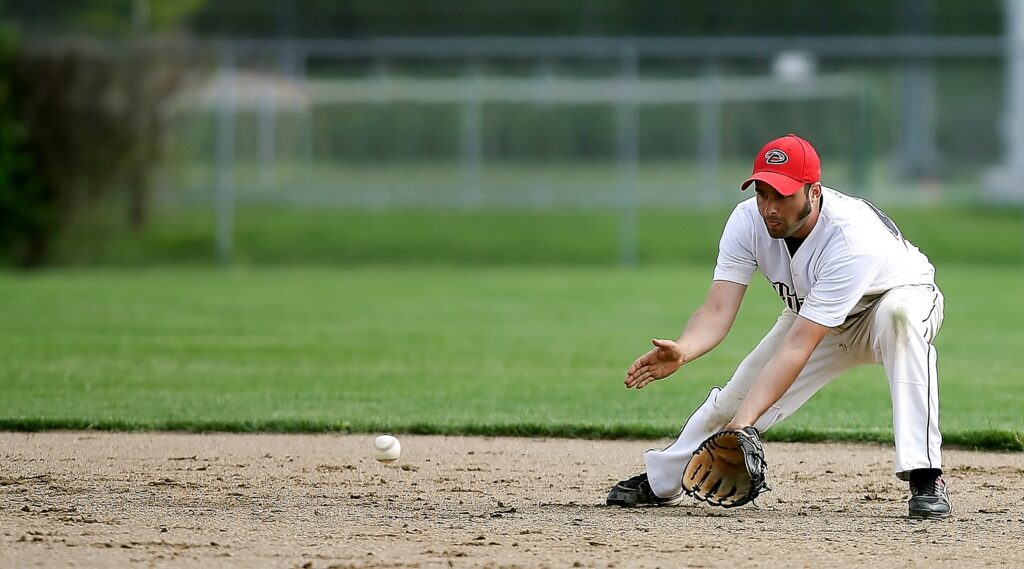This process will always start with being in the “ready position”. You want to be in an athletic stance, feet a little wider than shoulder width, with your glove out in front of you.
As the ball is about to be hit you want to be on your toes, with your momentum moving forward ever-so-slightly. You will commonly see infielders walking toward home plate a couple of steps and coming into their ready position just as the ball is entering the hitting zone.
The idea here is that you never actually come to a complete stop, so your reaction time is much better with a slight movement.
Contents
Fielding a ground ball in theory
No ground ball is ever exactly the same so we want to set a baseline of how to approach the ball at different stages.
You want to be moving from your right to your left as you field the ball whenever possible so that your momentum is moving in the direction that you want to throw the ball which is usually first base.
This is obviously not possible for many balls to your backhand side, or if you’re planning to throw the ball to a different base than first.
It’s important to keep your shoulders square to the ball while all of this is taking place.
1.Bucket Drill
This is a common drill in which you practice getting “around the ball” and fielding it with your momentum going toward first base.
You make a bit of a J shape in how you move which is why it’s coined the J drill. The idea is that the ball is coming toward you, as it gets closer you want to position yourself so the ball is lined up with your left foot.
As you come to the point of fielding the ball you will move to your left slightly so that you can move through the ball, straight line toward first base as you field and throw.
2.Fielding position
Once we’ve staged, we get our momentum right, then comes actually fielding the ball. You want your glove on the ground while your throwing hand is above the glove.
If you place your hand above the glove just so if the ball makes a bad hop it hits your hand, rather than coming up and hitting you in the face, you’re in good shape.
The glove should be on the ground more or less and as the ball goes into your glove you bring your throwing hand over the ball to cradle the ground ball into your glove.
We never close our glove fielding a ground ball unless it’s backhand.
3.Transition
Once you’ve secured the ball in your glove, in one fluid motion, we want to step in front of our left foot with our right foot, step and throw.
Seeing how most infielders are right-handed I’m coming from the perspective of a right-handed throwing person here.
Some first basemen would do the opposite with their feet if fielding and throwing the ball to a base not his own.
If you can imagine that you never actually come to a stop, your momentum should carry you toward where you want to throw the ball if you’ve done these steps correctly.
4.Fielding a ground ball backhanded by theory
This is a bit different as we cannot carry momentum through the ball most of the time when fielding the ball backhanded.
Sometimes however it is possible to get “around the ball” and carry a bit of momentum through the ball but often times in these cases you would want to get all the way around the ball and not field the ball backhanded.
That is a judgment call you must make as the fielder. Commonly when fielding a ball backhanded, you will be in a lunge position with your glove in between your legs (from the perspective of home plate).
You never actually want your glove between your legs if you’re looking down because you limit your range of motion of where you can field the ball.
Fielding a ground ball backhanded
So the ball is making its way toward you, and you’ve decided to field the ball backhanded.
Ideally, you will field the ball with your right foot planted solidly in the turf.
As you field the ball you close your glove around it and push off your right foot toward the base you want to throw it to. Step and throw.
5.Reading a hop
Reading a hop is probably the most important part of fielding a ground ball. You can do everything else wrong, but if you read the hop correctly, you have a shot.
The idea here is that you want to field the ball when it’s at the top of its bounce, or coming down.
It’s much easier to field the ball at this position than it is when the ball is coming off the ground and traveling up.
You time your attack to the ball based off of where you can position yourself to most easily field the ball.
This isn’t always possible and sometimes you will have to field a ball skipping across the ground or even pick a short hop.
6.Short hops
Fielding short hops is the hardest part about fielding a ground ball. Sometimes you haven’t read the hops correctly, sometimes you have no choice but to attack and pick a short hop to be able to throw the runner out in time.
Our instincts want us to be timid and stay back on a short hop but it’s the exact opposite you must train yourself to do if you want to be a successful defender.
When you realize you’re going to have to field a short hop you want to aggressively move your glove and momentum toward the ball.
The idea is to shorten the space between the ground and your glove, thus closing the margin for error.
This takes some practice and there are some simple yet profound drills to help you master this skill.
If you have access to a pitching machine or baseball rebounder here is great idea for practicing field hops:
Varying size and texture of balls cause a different affect in the machine.
— Kyle Wrighte (@InfieldAcademy) December 27, 2022
In the ATEC tennis balls don’t go as far and don’t back spin as much as a these foam balls.
Player was fielding tennis ball short hops and doing tag plays on foam ball throw downs pic.twitter.com/VO1iG8Wsr5
Final Word
We hope this list of drills will give you some good ideas that you can incorporate into your practice routine.
Like most things in baseball, the key is to put in the work and practice fielding all of the different types of ground balls that you may end up seeing during a game.
The best fielders I ever played with were guys that would work on their fielding outside of practice and really got after it.
The more work you put in toward fielding the more it will become second nature during game action and you will be on your way toward turning


